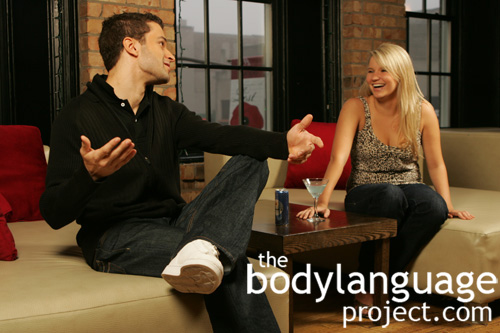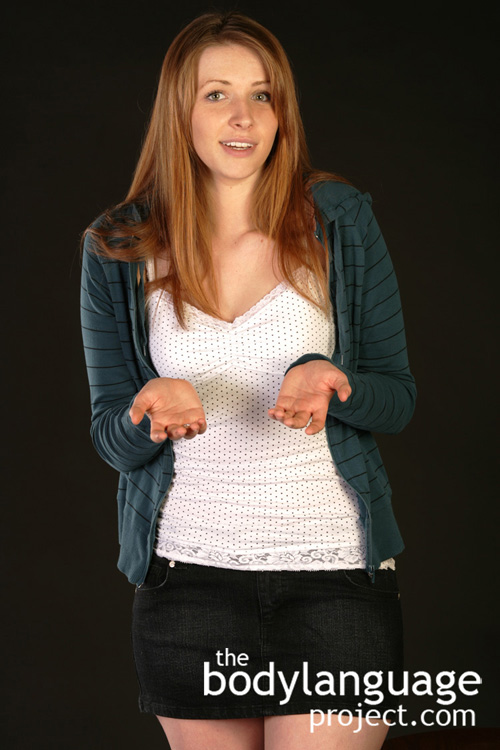Body Language of Palm Up Displays or The Rogatory Posture
Synonym(s): Palm Flash, (the) Offered, Open Palm, Rogatory Posture.
Description: In the palm up display, the hands are turned palm up rather than palm down or hidden from view (such as in pockets). The “rogatory” posture or “prayer-like” posture are terms used to describe outstretched arms with palms up. The palm-up gesture is used throughout the world. We recognize the gesture as an upward rotation of the palms, usually both hands, with fingers partially, or fully extended. The arms are either straight or flexed at the elbow with the wrist flexed or extended.
In One Sentence: Palm up is a cue indicates uncertainty, helplessness, confusion and deference and often accompanies “who,” “what,” “when,” “why,” “where,” and “how” questions.
How To Use it: Use palms up when trying to appear honest. Palm displays signal to others that you want to both offer and idea or accept an idea. This is the cue used when people want to show that they sincerely believe that they are correct and wish to plead with others to accept their opinion.
Palms up while gesturing is also highly effective in building rapport.
Other times, turning the palms up shows that one simply does not know. To make this appear most honest, turn the palms up in unison and with emphasis. Having only one palm up is uncommitted and if they are not uniform from left to right shows dishonesty.
Context: General.
Verbal Translation: a) “I’m displaying my palms because I’d like to offer you my ideas and thoughts.” b) “I’m showing you my hands because I want to show that I’m honest and carry no weapons.” c) “I’m holding my hands palm up because I’m trying to gain your trust through honesty – I carry no weapons and I’m trying to offer you my opinion; will you take it? Please.”
Variant: Palm down means the opposite of palm up. Palm down is a power position and shows dominance. Palm up also tends to expose the delicate and vulnerable wrists so coupled with the palm up display reinforces the overall meaning of palm up – offering and submission. See Palm Down and Palm Even, Wrist Exposure Displays.
Cue In Action: a) When trying to explain his position, he turned his palms up, moved them in and out and gestured in synchrony with his thoughts. He was offering his heartfelt view of the situation and desperately wanted to be believed. b) When asked if he knew where the missing doughnut had gone, he shrugged in submission and turned his palms up with enthusiasm. He sincerely didn’t know.
Meaning and/or Motivation: Palms-up, palms-down and palms even all represent different things, from authority to submission. Palms up are a signal of trustworthiness and are a positive, honest, signal. It signifies the desire to build rapport and is nonthreatening and submissive.
The palm-up cue is used to appease and we present it when we’re putting ourselves at risk. For example, we use the cue when asking a question because we realize that we may be ridiculed for our ignorance. Listeners may react negatively to us or laugh at us. We use the posture to show submission and lesson our chances of being challenged. After all, not knowing is a sign of weakness and our weakness is and should be coupled with visible defeat. All this stems from ancient processes which make our bodies take on a smaller, crouched posture, creating a smaller target for potential attack – referred to as “flexation withdrawal.”
In evolutionary terms, the palm display is an important gesture signifying honesty because it is a way to make evident to others that no threat or weapon is present (such as a spear, sword or bow and arrow). Palm flashes are essentially what would have happened thousands of years ago when two foreign tribes met.
Palm and wrist displays have also been noted to be sexual in nature and more frequently flashed by women during courtship likely because it is such a vulnerable part of the body.
The palm up cue is recognized in sign language of the deaf from the U.S. to Colombia and Papua New Guinea. In other words, the cue is likely universal.
Dr. David B. Givens argues that the palm- up gesture originated from primitive pectoral communication (think fish).
Overall, the palm-up gestures, is said by Givens to be a part of a larger shoulder-shrug display. As such, it originates from a crouched posture, or flexation withdrawal. The main actor is the upper trapezius which functions to lift the scapulas. He reminds us that theses muscular movements are incredibly ancient and much like facial expressions, are motivated by emotions. The same nerves that innervates the trapezius (cranial XI), also feeds the larynx. This is why we often accompany a shoulder shrug with a high-pitched, submissive voice tone. In other words, Givens says that muscles that move the larynx and pectoral girls evolved from muscles that originally opened the mouths and gills of ancient fishes.
The palm up gesture is adapted for social communication. The gestures are often paired with words – or vocal roars, drumming sounds (from swim bladders and “singing” which might come from a whale’s respiratory system.
According to Givens, “We do not ordinarily make conscious choices about these gestures. Emotions responsible for palm-up movements are located above the spinal cord in defensive areas of the forebrain’s limbic system (notably the amygdala), passing through basal ganglia and brain-stem links to the spinal cord below. The emotional brain unthinkingly touches off flexor-withdrawal movements designed to protect from real or imagined harm.”
On the other hand, when we view the posture in others, we intuitively decode the message with the help of mirror neurons. These are specialized structures in the brain which subconsciously activate a motor template, or brain blueprint, which help us empathize immediately with the person emitting the cue.
In other words, the entire process is innate, ancient and totally “out of our hands.”
Givens also challenges the idea that the palm up cue is about “offering.” In this metaphor, it is argued that the palms are a container by which we give an idea to someone else. However, he says this explanation falls short. He says that palm up gesture are more about social relationships. Rather than offering and receiving ideas, the posture is more about how one presents the self in relative status to another. When one is asking, pleading, appealing, showing uncertainty, questioning, or acting in deference, then one should accompany ones relative position with a posture that is congruent.
“What you are seeing when you watch a palm-up sign is a continuation of a movement pattern that has survived for hundreds of millions of years. In essence, you see a “gestural fossil” from antiquity that continues to broadcast today,” says Givens.
In other words, the posture is no accident, not conscious or learned, entirely innate and therefore of predictable nonverbal meaning.
Cue Cluster: Palms up is accompanied by relaxed and open facial expressions, relaxed stance, calm breathing and other natural body postures. When stress is evident, but honesty still present, a person might be seen with a tensed face, but the palms will flash consistently and with enthusiasm. The disconnect comes from the misery of not being believed and the worry that comes from potential negative consequences. The enthusiasm with the palm flash indicates a desire to show honest conviction. When lying is present, a person will flash their palms but with low amplitude and lack of symmetry from left to right.
Body Language Category: Amplifier, Gesticulation, Honest body language, Nonthreatening body language, Open body language, Palm power, Rapport or rapport building.
Resources:
Blurton Jones, N. G. (1967). “An Ethological Study of Some Aspects of Social Behaviour of Children in Nursery School.” In Desmond Morris (Ed.), Primate Ethology (Chicago: Aldine), pp. 347-68.
Brannigan, Christopher, and David Humphries (1972). “Human Non-Verbal Behaviour, A Means of Communication.” In N. G. Blurton-Jones, ed., Ethological Studies of Child Behaviour (Cambridge: University Press), pp. 37-64.
Bass, Andrew & Boris P. Chagnaud. 2013. Shared developmental and evolutionary origins for neural basis of vocal–acoustic and pectoral–gestural signaling. Proceedings of the National Academy of Sciences.
Birdwhistell, Ray. 1952. An introduction to kinesics. Louisville: University of Louisville.
Birdwhistell, Ray. 1970. Kinesics and context. Philadelphia: University of Pennsylvania.
Ekman, Paul, and Wallace V. Friesen (1969). “Nonverbal Leakage and Clues to Deception.” In Psychiatry (Vol. 32), pp. 88-106.
Ekman, Paul & Wallace V. Friesen. 1972. Hand movements. Journal of Communication. Vol. 22, Dec. 1, pp. 353-374.
Engel, George. 1978. Clinical value of gestures, postures, and facial expressions. Public lecture. University of Washington. Seattle. December 5.
Ferre, Gaelle. 2011. Functions of three open-palm hand gestures. Multimodal Communication, 2011, 1 (1), pp.5-20.
http://hal.archives-ouvertes.fr/docs/00/66/60/25/PDF/Multimodal-com-Ferre_final_.pdf
Fabrega, Horatio Jr. 1973. Begging in a southeastern Mexican city.” In Romney, A. K. & I. DeVore (eds.). You and others. Cambridge, Mass.: Winthrop, pp. 162-173.
Friesen, Wallace ; Ekman, Paul ; Wallbott, Harald. Measuring hand movements. Journal of Nonverbal Behavior. 1979. 4(2): 97-112.
Goffman, Erving. The Nature of Deference and Demeanor. American Anthropologist. 1956. 58(3): 473-502.
Givens, David B. (forthcoming). “Reading Palm-up Signs: Neurosemiotic Overview of a Common Hand Gesture” (Accepted for publication [March 4, 2015] in Semiotica).
Givens, David B. (1982). “From Here to Eternity: Communicating With the Distant Future.” In Et Cetera (Vol. 39, No. 2), pp. 159-79.
Givens, David B. (forthcoming). “Reading Palm-up Signs: Neurosemiotic Overview of a Common Hand Gesture” (Accepted for publication [March 4, 2015] in Semiotica).
Givens, David B. (1978C). “Social Expressivity During the First Year of Life.” In Sign Language Studies (20), pp. 251-274.
Givens, David B. (1978D). “Greeting a Stranger: Some Commonly Used Nonverbal Signals of Aversiveness.” In Semiotica (Vol. 22), pp. 351-67.
Grant, Ewan (1969). “Human Facial Expressions.” In Man (Vol. 4), pp. 525-36.
Givens, David B. 1977. Shoulder shrugging: A densely communicative expressive behavior. Semiotica. Vol. 19:1/2, pp. 13-28.
Givens, David B. 1982. An ethological approach to the study of human nonverbal communication. Ann Arbor: University Microfilms.
Givens, David B. 1986. The big and the small: Toward a paleontology of gesture. Sign Language Studies. No. 51. Summer, pp. 145-167.
Givens, David B. 2005. Love signals: A practical field guide to the body language of courtship. New York: St. Martin’s Press.
Givens, David B. 2014b. Nonverbal neurology: How the brain encodes and decodes wordless signs, signals, and cues. In Kostic, Aleksandra & Derek Chadee (eds.). Social psychology of nonverbal communication. New York: Palgrave-MacMillan Press, pp. 9-30.
Givens, David B. 2014c. Measuring gestures. In Kostic, Aleksandra & Derek Chadee (eds.). Social psychology of nonverbal communication. New York: Palgrave-MacMillan Press, pp. 66-91.
Goffman, Erving. 1956. The nature of deference and demeanor. American Anthropologist. Vol. 58, No, 3, June, pp. 473-502.
Goodall, Jane. 1986. The chimpanzees of gombe: Patterns of behavior. Cambridge: Belknap Press of Harvard University.
Hall, Jeffrey A. and Chong Xing. The Verbal and Nonverbal Correlates of the Five Flirting Styles. Journal of Nonverbal Behavior. 2015. 39:41–68. DOI 10.1007/s10919-014-0199-8
http://bodylanguageproject.com/articles/first-12-minutes-flirting-using-nonverbal-communication-study-reveals-26-body-language-cues-attraction/
Hall, Karl & Irven DeVore. 1972. Baboon social behavior. In Phyllis Dolhinow (ed.). Primate patterns. San Francisco: Holt, Rinehart, and Winston, pp. 125-180.
Hubbard, Amy, McNealy, K., Zeeland, A., Callan, D. & M. Dapretto. 2012. Altered integration of speech and gesture in children with autism spectrum disorders. Brain and Behavior. Vol. 2, No. 5, Sept. 2012, pp. 606-619.
Iacoboni, Marco. 2009. Imitation, empathy, and mirror neurons. Annual Review of Psychology. Vol. 60, pp. 653-670.
Kendon, Adam. 2004. Gesture: Visible actions as utterance. Cambrideg: Cambridge University Press.
Lee Ann Renninger, T. Joel Wade, Karl Grammer. Getting that female glance: Patterns and consequences of male nonverbal behavior in courtship contexts. Evolution and Human Behavior. 2004; 25: 416–431.
http://bodylanguageproject.com/articles/part-i-how-to-read-male-sexual-body-language-a-study-for-women-and-the-men-who-wish-to-cheat-the-system/
Moore, Monica. Courtship Signaling and Adolescents: Girls Just Wanna Have Fun. Journal of Sex Research. 1995. 32(4): 319-328.
http://bodylanguageproject.com/articles/girls-just-want-to-have-fun-the-origins-of-courtship-cues-in-girls-and-women/
Morris, Desmond (1994). Bodytalk: The Meaning of Human Gestures (New York: Crown Publishers).
Morris, Desmond (1994). Bodytalk: The Meaning of Human Gestures (New York: Crown Publishers).
Marler, Peter. 1965. Communication in monkeys and apes. In DeVore, I. (ed.), Primate behavior. New York: Holt, Rinehart & Winston, pp. 544-584.
McNeill, David. 1992. Hand and mind: What gestures reveal about thought. Chicago: University of Chicago Press.
McNeill, David. 2005. Gesture and thought. Chicago: University of Chicago Press.
Mittelberg, Irene. 2008. Peircean semiotics meets conceptual metaphor: Iconic modes in gestural representations of grammar. In Cienki, A. & C. Müller (eds.). Metaphor and gesture. Amsterdam/Philadelphia: John Benjamins, pp. 115-154.
Montgomery, Kimberly J., Isenberg, Nancy & James V. Haxby. 2007. Communicative hand gestures and object-directed hand movements activated the mirror neuron system. Social Cognitive and Affective Neuroscience. Vol. 2, No. 2, June, pp. 114-122.
Muller, C. 2004. Forms and uses of the palm up open hand: A case of gesture family?” In Muller, C. & Ronald Posner (eds.). The semantics and pragmatics of everyday gestures. Berlin: Weidler, pp. 233-356.
Norton, R. (1983). Communicator Style: Theory, Applications, and Measures (Beverly Hills: Sage Publications).
Navarro, Joe. 2008. What Every BODY is Saying: An Ex-FBI Agent’s Guide to Speed-Reading People. William Morrow Paperbacks.
Pease, Barbara and Allan Pease. 2006. The Definitive Book of Body Language Hardcover. Bantam.
Sturman, Edward D. Invluntary Subordination and Its Relation to Personality, Mood,
and Submissive Behavior. Psychological Assessment. 2011. 23(1): 262-276 DOI: 10.1037/a0021499
http://bodylanguageproject.com/articles/nonverbal-submission-men-women-depression-critical-examination-use-disuse-submission/
Waal, Frans De (1982). Chimpanzee Politics (London: Jonathan Cape).
Xu, Jiang, Gannon, Patrick J., Emmorey, Karen, Smith, Jason F. & Allen R. Braun. 2009. Symbolic gestures and spoken language are processed by a common neural system. Proceedings of the National Academy of Sciences.



